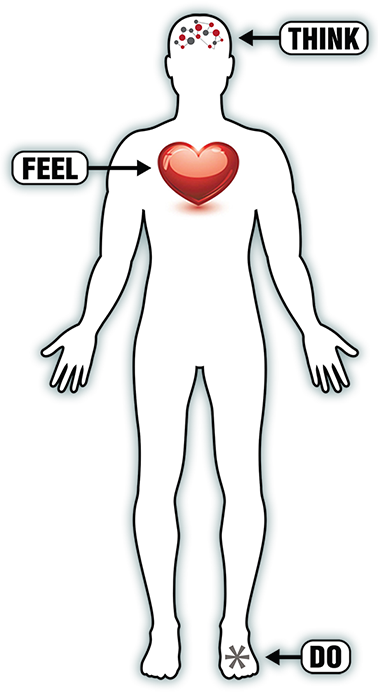When it comes to unhealthy relationships, the most common types of people are: those who desperately cling on out of unmet longing from childhood wounds (the Anxious), and those who avoid connection from being engulfed or feeling unsafe from childhood wounds, (the Avoidant). If you vacillate between the two you are an Ambivalent. This type of relationship is difficult to navigate however easy to fall into. We are drawn to what’s familiar regardless of merit.
For someone with an ambivalent attachment style (also called anxious avoidant), making a decision and acting on it can be so painful that they become stuck in rumination, self-doubt, spiraling thoughts, negative feelings, and constant gridlock in their heads.
Typically, an ambivalent individual has expectations that others will change or do something to create movement in the relationship so they won’t have to. And then, when others take action in the relationship by making decisions and stepping into them, it’s often the Ambivalent, who will burn with low-grade resentment and anger underneath. In other words, there’s a constant tug of war in the relationship: change or status quo. And, Sigmund Freud described emotional ambivalence as having simultaneous feelings of love and hate in the relationship.
How Ambivalence Manifests In Your Parts of Self

Ambivalent individuals will THINK about what to do, FEEL what will happen if they take action, question it, and THINK some more, and then more FEELings will surface, and then they will THINK some more, and the cycle continues. There is not a lot of DOing (action) taking place.
The inaction of the ambivalent partner plays out over and over, repeatedly.
Meanwhile, let’s assume the opposite of the ambivalent partner, is someone who has a secure attachment style. Let’s say that the secure partner grew up in a much more stable and constructive environment during their childhood and adolescence, or they’ve done their personal growth work later in life. Attaching securely to an ambivalent romantic relationship is possible. It’s up to the secure partner to leverage their internal circle boundaries with a secure attachment to keep themselves healthy and stable in the relationship. And, if their beloved who struggles with relationship ambivalence, is aware of their common attachment style and can trust their partner to make decisions while they work on overcoming their ambivalence, they can deepen their level of emotional intimacy.
What Does It Mean To Be An Ambivalent Person?
Characteristics of Ambivalent individuals are:
- Conflict in decision making
- A “Come here go away” relational style
- They can’t seem to not second guess themselves
- Sends mixed signals to others
- Inconsistent in commitments
- Crippling indecisiveness
- Relies on others for decision making
- Stays in hopeless relationships hoping the other partner will break up first
- Has to go to “committee” when making decisions

The following are examples of how different types of ambivalent individuals interact in their respective romantic relationships:
Fear of Intimacy In Ambivalence
Most Ambivalent individuals have a tendency of being unsure of the choice they have made in a partner. This creates an internal conflict and fear of intimacy. If they get “too close” they could be hurt because their partner might not be the right fit. However the indecisiveness keeps them tethered to the relationship. This ambivalent attachment style, more than any other, feeds on fantasies and delusions. Often Ambivalent individuals will sabotage relationships when they start to get serious or at whatever point the fear of intimacy comes up. This comes up anytime (before the first date, after the first date, after sex, after the subject of commitment comes up, after the engagement, after the wedding) whenever.
Running Hot and Cold In Ambivalence
Some Ambivalents run hot and cold. They always come on to you when they want sex or companionship. When they become bored or frightened, they begin withholding companionship, sex, and affection, anything that makes them feel anxious. If they keep repeating the pattern of being available/unavailable in the same relationship, they withhold intimacy. They tend to offer more intimacy each time they come back. They up the stakes with offers of commitment, living together, marriage, children, etc. They rarely keep their promises to change.
Bonding in Ambivalence
Some Ambivalents are simultaneously addicted to multiple romantic partners. Unlike sex addicts, who are trying to avoid bonding altogether, these Ambivalents bond with each of their partners, to one degree or another, even if the romantic liaisons are short-lived. These Ambivalent individuals are often confused with Sex Addicts.
Complexity and Ambivalence
The most complicated kind of Ambivalent is someone who has been labeled a Narcissist. On the surface, he or she is usually aloof, detached, self-confident, self-centered, domineering, and/or afraid of commitment. However, when you leave this individual, what appeared like Narcissism is quickly seen as ambivalent behavior because they can’t handle being rejected. They turn to manipulation, aggression, and even violence to hold on to the relationship even though they remain ambivalent. It is a common pattern for Ambivalents to obsess when someone is unavailable and then become ambivalent when a healthy person comes along.
Ambivalence And Childhood Trauma
Ambivalence attachment style can result for complicated divorces. When a child or adolescent goes through a divorce (yee, they go through it too), there is often a split that occurs in the parenting styles, expectations, household rules/guidelines, sometimes they are even put in the middle of the complicated trauma and drama. Children and adolescents are sometimes the recipient of the emotional complexity of the parent who is distraught from the divorce. All of this can cause distrust in relationships later in life for the child and adolescent.
In some cases, ambivalents suffer from some form of childhood incest (overt, covert, or emotional) and they fall in love but abort the relationship when it gets too serious. (By incest I mean overt (sexual molestation and rape); covert (sexual energy without touching); and emotional incest (being forced to be a surrogate partner.) Research this for yourself, and I recommend The Emotional Incest Syndrome by Patricia Love or The Courage to Heal by Laura Davis.

Are You Ambivalent? A Self Evaluation
Remember that you may not have all the characteristics of an ambivalent attachment style – however, when you read them, you will get a feel for what you have done and may expect to still do in your intimate relationships:
- I find myself in rocky and/or dramatic relationships with highs and lows (romantic, family, and friend relationships)
- In relationships, I have fears of being abandoned and also fear being close/intimate.
- I tend to cling to partners when I feel rejected, yet I feel trapped when things get too close.
- My relationships have a push-pull, come here-go away pattern.
- I find myself obsessing about love through romantic fantasies about unavailable people.
- I crave a deep relationship, but I find it hard to trust and open up to a deeper level of intimacy.
- I often find myself “stuck” or “trapped” in relationships that I don’t find self-honoring or meet my needs.
- I create intensity in other things outside of my relationship (work, hobbies, friends, affairs, addictions) that create emotional distance in the relationship.
- When I’m making a decision, I find myself in an “internal battle” and find it hard to get into action.
- I usually feel confused about the “right” thing to do, so I end up doing nothing.
- I need to go towards others to get my needs met, but I fear getting too close to others and getting hurt.
- I wait for the other person to break up first.
What Are Ambivalent Feelings?
Ambivalent feelings are mixed or conflicting emotions towards a person, object, or situation. They involve experiencing both positive and negative emotions at the same time, which can create a sense of uncertainty or discomfort.
For example, a person may be feeling ambivalent towards a job opportunity, experiencing excitement about the potential benefits but also anxiety about the challenges and risks involved. Similarly, a person may feel ambivalent towards a romantic partner, experiencing both love and frustration or anger at different times.
Ambivalent feelings are common in situations where there are both good and bad aspects to the object of the emotions. They can create confusion and indecisiveness, making it difficult to make clear decisions or take action. However, by acknowledging and exploring ambivalent feelings, individuals can gain a deeper understanding of themselves and the situation, resolve conflict, and make more informed choices.
Additional Mixed Feelings in Ambivalent Relationships
- Love and hate: feeling both intense affection and anger or frustration towards a person or situation.
- Excitement and anxiety: feeling both eager anticipation and apprehension or worry about an upcoming event or decision.
- Trust and mistrust: feeling both faith and doubt about a person’s intentions or actions.
- Gratitude and resentment: feeling both appreciation and bitterness towards a person or situation.
- Hope and despair: feeling both optimism and pessimism about the future or a specific outcome.
- Pride and shame: feeling both a sense of accomplishment and embarrassment or guilt about one’s actions or behavior.
- Happiness and sadness: feeling both joy and sorrow about a particular event or situation.
- Empathy and envy: feeling both understanding and jealousy towards another person’s experiences or achievements.
- Admiration and disdain: feeling both respect and contempt towards a person or situation.
- Excitement and guilt: feeling both enthusiasm and remorse about engaging in a particular activity or behavior.
What To Do If Your Partner Is Ambivalent?
If your partner is ambivalent, it can be a challenging and confusing situation to navigate. Here are some things you can do:
- Communicate openly: Talk to your partner about their feelings and try to understand what is causing their ambivalence. Encourage them to express their thoughts and emotions, and listen to them without judgment.
- Validate their feelings: Let your partner know that you understand and accept their ambivalent feelings. It’s important to show empathy and compassion towards them.
- Don’t pressure them: Avoid pressuring your partner to make a decision or take action if they are not ready. Allow them time and space to process their emotions and make their own choices.
- Seek help: Consider seeing a professional to help you and your partner work through the ambivalence and any related issues.
- Take care of yourself: Make sure to take care of your own emotional needs and well-being during this challenging time. Engage in self-care activities such as exercise, mindfulness, and spending time with supportive friends and family.
How Do You Manage Ambivalence In A Relationship?
In summary, the Ambivalent is a complicated person. When treated by an experienced individual who specializes in Attachment, one can change. It takes time, willingness to dive deep into the wounds and onboard patience for a new level of relational tolerance to take place. The ultimate goal is to learn how to attach securely with self and others. If you want to improve your romantic relationship and you or your partner is exhibiting ambivalent behaviors, we can help.
At PIVOT, we specialize in teaching you to cope and deal with old behaviors that don’t serve you in real time, so that you can then lead and live your new life as what we call a Healthy Adult, using PIVOT’s unique tools and process. It’s not impossible to change. It is possible to understand yourself and learn to make different choices to get what you want and need in loving relationships.

We offer a range of workshops and retreats for couples and individuals, all based on compassion and experience. With our carefully designed curriculum, known as the PIVOT process, you can learn to evaluate your thoughts and feelings and take appropriate action to support and improve your relationships so that you can feel connected with your partner. Contact us today. We encourage you to reach out and start your healing journey!